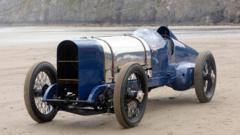Can the World's First 150mph Car Break Records Again at the Beach?

A Century of Speed: Celebrating the Legacy of Malcolm Campbell and Blue Bird
In 1925, a pivotal moment in automotive history unfolded on the sandy shores of Pendine Sands in south-west Wales. It was here that Malcolm Campbell, an ambitious car dealer, aimed to shatter the 150 mph barrier with his powerful 350-horsepower Sunbeam car, aptly named Blue Bird. This location, stretching seven miles, provided the perfect setting for a high-speed endeavor that would etch Campbell's name into the annals of land-speed record history. On July 21, 1925, he accomplished what many deemed impossible, recording an average speed of 150.766 mph, thereby catapulting himself to international fame and establishing Pendine as a crucial stage for speed racing. Now, as we approach the centenary of this remarkable achievement, the legacy of Blue Bird and the Campbell family continues to inspire and excite automotive enthusiasts around the globe.
The Historic Context of Pendine Sands
Pendine Sands, located in Carmarthenshire, Wales, served as an ideal venue for land-speed record attempts in the 1920s. The expansive beach allowed for long stretches of acceleration and deceleration, a crucial factor as cars began to reach unprecedented speeds. Unlike traditional racetracks, where the confines of a circuit could limit performance, Pendine offered an open canvas for speed enthusiasts. Campbell's early attempts at the record were met with fierce competition, particularly from John Godfrey Parry Thomas, who also sought to push the boundaries of automotive speed.
Malcolm Campbell's Journey to 150 mph
Malcolm Campbell was no stranger to risk. Having set and lost the land-speed record multiple times before, his determination was fueled by a desire to not only break barriers but to cement his legacy. The 1925 attempt was marked by meticulous planning and engineering prowess, with Blue Bird being a modified racing car designed to withstand the rigors of speed. On that fateful day, Campbell’s two runs secured him the record, and the spectacle was witnessed by a captivated audience, both on-site and through global media coverage.
The Campbell Legacy
The Campbell family is synonymous with speed records. Malcolm Campbell’s son, Donald Campbell, achieved the incredible feat of holding both the land and water-speed records simultaneously, further elevating the family's legacy. Tragically, Donald lost his life during a record attempt at Coniston Water in 1967, but his achievements left an indelible mark on the world of speed. Donald's daughter, Gina Campbell, followed suit by breaking the women's world water-speed record, proving that the quest for speed is a family affair.
The Modern-Day Celebrations
As we commemorate the 100th anniversary of Campbell’s groundbreaking achievement, Don Wales, Malcolm Campbell’s grandson, is set to lead the celebrations. The original Blue Bird will once again make an appearance at Pendine Sands, a symbolic return to its birthplace. This ceremonial start-up is not just a tribute to the past; it serves as a reminder of the relentless pursuit of speed that runs through the Campbell lineage. Don Wales has stated that there is a genetic predisposition within the family for speed, attributing their racing spirit to their Scottish ancestry.
The Evolution of Land-Speed Records
The quest for speed has evolved dramatically since the days of Campbell and Parry Thomas. Between 1924 and 1927, these two pioneers pushed the record from a mere 140 mph to an astonishing 176 mph, showcasing the engineering advancements and sheer willpower of the era. However, the rivalry took a tragic turn when Parry Thomas lost his life during a record attempt in his self-built car, Babs. This moment not only highlighted the dangers associated with speed but also intensified the competitive spirit surrounding land-speed records.
The Contrasting Approaches to Speed
The contrasting philosophies of Campbell and Parry Thomas fueled public fascination. Campbell's Blue Bird was primarily a sleek racing car adapted for land-speed attempts, while Parry Thomas’s Babs was purpose-built for record-breaking endeavors. This divergence in design and focus on speed offered enthusiasts a glimpse into the varying strategies employed by drivers seeking to claim the title of the fastest on land.
The Legacy of Blue Bird
Today, the original Blue Bird is preserved at the National Motor Museum in Beaulieu, Hampshire. However, the car's journey has not been without challenges. After being rescued from a barn in the 1950s, Blue Bird faced decades of neglect before an ill-fated attempt to restart its engine in 1993 resulted in significant damage. The subsequent repair process took nearly a decade, highlighting the passion and dedication of the team working to restore such a historic vehicle. Ian Stanfield, the chief engineer at Beaulieu, expressed concerns about the future of automotive preservation, emphasizing the need for training the next generation of experts in this specialized field.
The Future of Land-Speed Records
Despite the challenges faced in preserving historical vehicles like Blue Bird, the future of land-speed records is bright. Don Wales reflects on the incredible advancements in technology and engineering that have emerged in recent years. With two projects currently aiming to surpass the 1,000 mph milestone, the spirit of competition and innovation remains strong. As interest in speed continues to grow, the potential for new records and breakthroughs is limitless, provided the infrastructure exists to accommodate such ambitious pursuits.
Challenges in the Pursuit of Speed
One of the most significant challenges facing modern land-speed record attempts is finding a suitable location that can accommodate the necessary distances for acceleration and deceleration. The pursuit of speed is not just about the vehicles; it also requires a carefully considered environment that can support the extreme demands placed on both the driver and the machine. As engineers and drivers work together to push the limits, it will be fascinating to see how these challenges are addressed in the coming years.
Conclusion: A Legacy of Speed and Innovation
The story of Malcolm Campbell and Blue Bird is one of ambition, innovation, and the relentless pursuit of speed. As we celebrate the centenary of Campbell's record-breaking achievement, we honor not only the legacy of a remarkable individual but also the spirit of exploration that drives humanity to reach for the extraordinary. The Campbells have shown us that with determination, courage, and a bit of engineering magic, barriers can be broken. As we look to the future of land-speed records, one can only wonder what new heights will be reached and what stories will emerge from the ongoing quest for speed.
FAQs
What was the significance of Malcolm Campbell's record in 1925?
Malcolm Campbell's record in 1925 was significant as it marked the first time a car broke the 150 mph barrier, showcasing the potential of automotive engineering and establishing Pendine Sands as a crucial site for land-speed records.
Who were the key figures in the Campbell family's racing legacy?
The key figures in the Campbell family's racing legacy include Malcolm Campbell, who set the first 150 mph record; his son Donald Campbell, who held both land and water-speed records simultaneously; and his granddaughter Gina Campbell, who broke the women's world water-speed record.
What challenges did Blue Bird face in its preservation?
Blue Bird faced numerous challenges in preservation, including being neglected for decades, suffering engine damage during a restart attempt, and the difficulties of sourcing original parts for repairs, which took nearly ten years to complete.
What is the future of land-speed records?
The future of land-speed records looks promising, with ongoing projects aiming to exceed 1,000 mph. However, challenges such as finding suitable locations for speed trials will need to be addressed as technology and engineering continue to advance.
As we celebrate the legacy of speed and innovation, what do you think the next century holds for land-speed records? Will we witness even greater feats of engineering and human courage? #LandSpeedRecord #BlueBird #CampbellLegacy
Published: 2025-07-19 21:00:12 | Category: wales



